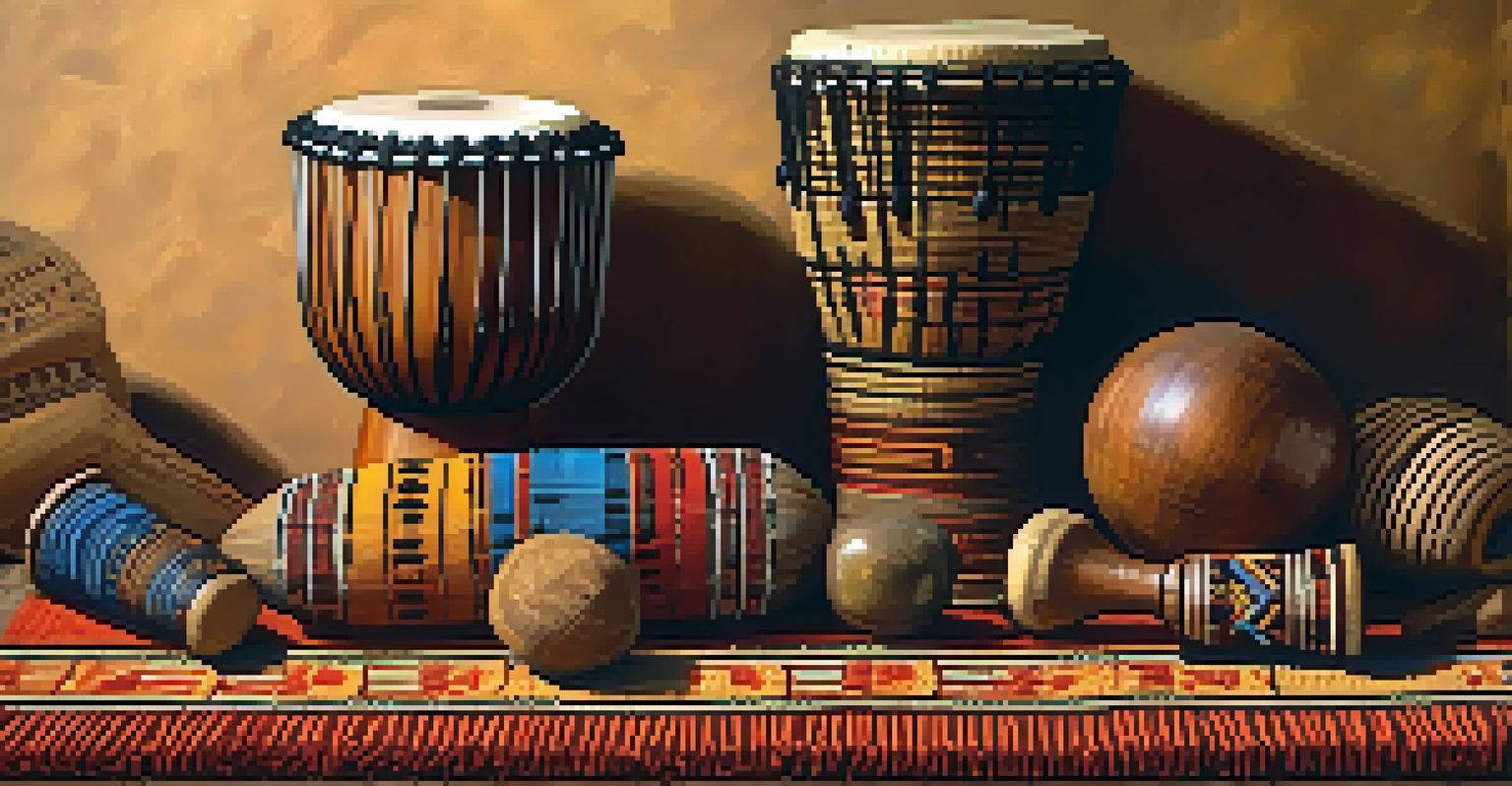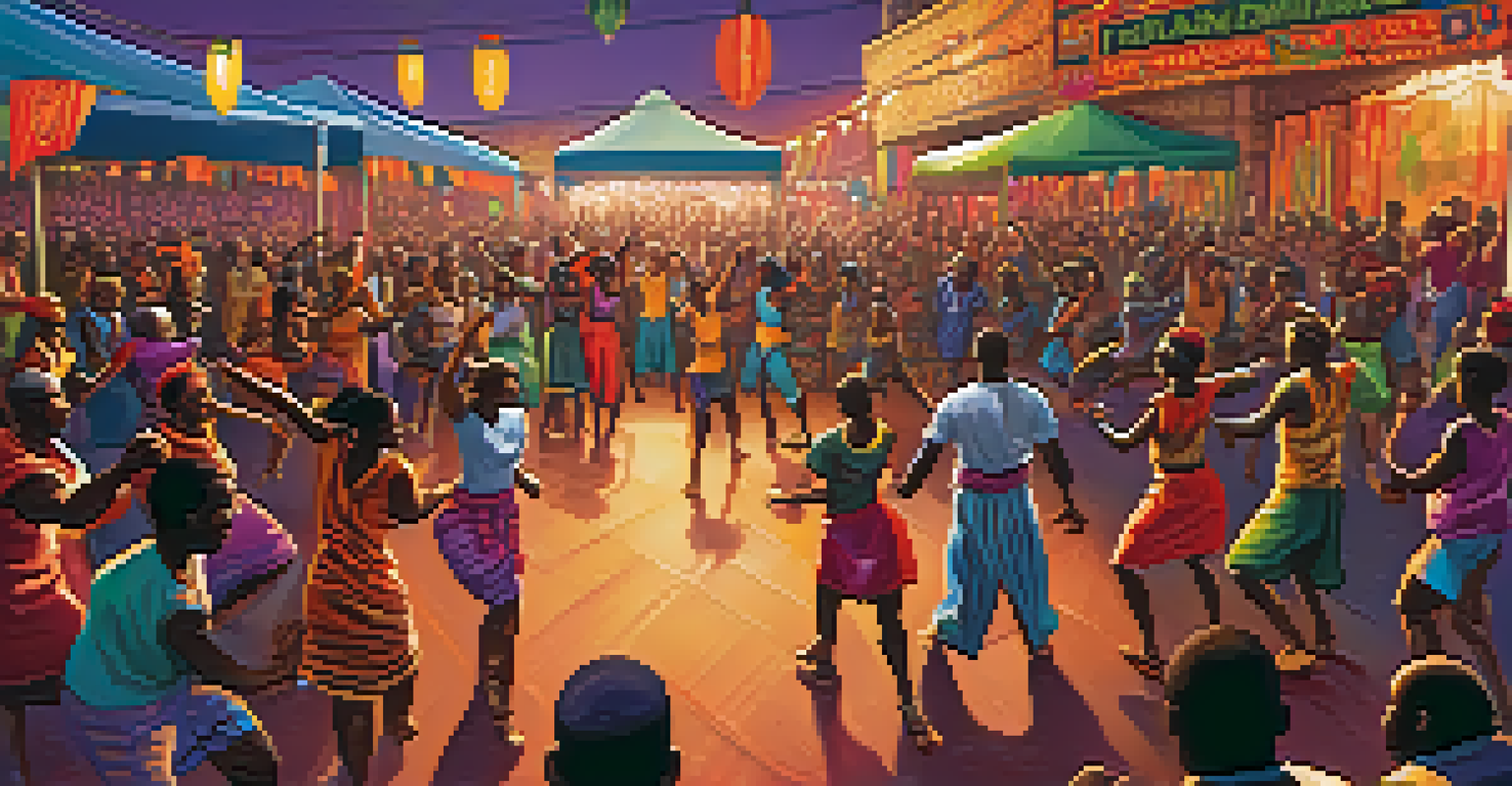African Folk Dance: A Celebration of Community and History

The Roots of African Folk Dance: A Historical Overview
African folk dance is deeply intertwined with the continent's rich history. Each dance form tells a story, reflecting the unique cultural heritage of various communities. From the rhythmic beats of the drum to the vibrant costumes, these elements showcase the traditions passed down through generations.
Dance is the hidden language of the soul.
Historically, dances were often performed during communal gatherings, celebrations, and rituals, serving as a means of storytelling and preserving history. As societies evolved, so did their dances, adapting to changes while still honoring ancestral practices. This evolution highlights the resilience and creativity of African cultures.
Today, folk dance remains a vital part of African identity, celebrated not just within communities but also on the global stage. The increasing interest in African dance forms is a testament to their significance, bridging cultural gaps and fostering understanding among diverse audiences.
Community Connection: The Role of Dance in Social Bonds
In many African cultures, dance acts as a powerful tool for social cohesion. It brings people together, fostering a sense of belonging and community spirit. Whether it's a wedding, a harvest festival, or a funeral, dance plays a central role in marking important life events.

The communal aspect of dance encourages participation and connection, breaking down barriers between individuals. Everyone, regardless of age or ability, is invited to join in, creating an inclusive atmosphere that strengthens social ties. This shared experience cultivates unity and reinforces cultural identity.
Dance as Cultural Storytelling
African folk dance serves as a vital means of storytelling, preserving history and cultural identity through dynamic movement and communal participation.
Moreover, dance serves as a platform for storytelling, with each movement carrying meaning and significance. As participants engage in dance, they embody their history and values, ensuring that their cultural narratives are passed on to future generations.
The Diversity of African Dance Styles: A Cultural Mosaic
Africa is home to a stunning array of dance styles, each with its unique characteristics and cultural significance. From the energetic Adumu of the Maasai people in Kenya to the graceful Umteyo of the Xhosa in South Africa, every dance offers a glimpse into the lives of its practitioners. These styles can vary significantly even within the same region, reflecting the diversity of customs and traditions.
The dance is a poem of which each movement is a word.
For instance, some dances are characterized by their fast-paced movements and intricate footwork, while others may focus on fluid, sweeping gestures. The differences can be attributed to various factors, including geography, social structure, and historical influences. This diversity serves as a reminder of the continent's rich cultural tapestry.
Furthermore, these dance forms often incorporate elements of music, costume, and rhythm, creating a multisensory experience that captivates audiences. As dancers perform, they not only celebrate their heritage but also invite others to appreciate the beauty of their traditions.
Instruments and Music: The Heartbeat of African Dance
Music is an integral part of African folk dance, with various instruments playing a crucial role in setting the tone and rhythm. Drums, in particular, are considered the heartbeat of the community, providing a powerful driving force that energizes dancers. Each beat resonates with the spirit of the people, drawing them into a collective celebration.
Traditional instruments like the djembe, balafon, and kora are commonly used, each producing distinct sounds that complement the dance movements. The interplay between music and dance creates a dynamic experience, where rhythm guides the dancers and enhances their expression. This synergy between sound and motion is what makes African dance so captivating.
Community and Connection through Dance
Dance fosters social bonds, bringing people together to celebrate important life events and creating an inclusive atmosphere that strengthens community ties.
Moreover, vocal music, often featuring call-and-response patterns, encourages participation and engagement from the audience. This communal singing fosters a sense of unity, enriching the overall experience and ensuring that everyone feels connected to the performance.
Dance as a Medium of Education: Passing Down Knowledge
African folk dance is not just entertainment; it serves as a vital educational tool for passing down knowledge and values. Through dance, younger generations learn about their heritage, cultural practices, and the significance of their community. This form of education is often more engaging and memorable than traditional methods.
For example, many dances incorporate lessons about agriculture, history, and social responsibilities, allowing participants to internalize these teachings while enjoying the physical expression of movement. This hands-on approach to learning makes the lessons resonate deeply, ensuring they are cherished and remembered.
As elders share their knowledge through dance, they create a bridge between past and present, fostering a sense of pride and identity among younger generations. This intergenerational exchange reinforces the importance of cultural continuity, ensuring that the richness of African traditions endures.
Modern Influences: The Evolution of African Dance
While rooted in tradition, African folk dance is continually evolving, influenced by contemporary trends and global interactions. In recent years, there has been a growing fusion of traditional dance with hip-hop, jazz, and other modern styles, creating exciting new forms of expression. This blending not only attracts younger audiences but also revitalizes interest in traditional practices.
Moreover, the global dance community has embraced African dance styles, leading to collaborations that celebrate this vibrant art form. Dance workshops, performances, and festivals showcase African dance, allowing it to reach a wider audience and gain recognition on the world stage. This exposure contributes to a greater understanding and appreciation of African cultures.
Evolving Traditions in Modern Dance
While rooted in tradition, African dance continues to evolve by incorporating contemporary influences, ensuring its relevance and appeal to new generations.
However, as dance evolves, it is essential to remain mindful of cultural respect and authenticity. Balancing innovation with tradition ensures that the essence of African folk dance is preserved while embracing the dynamic nature of artistic expression.
Celebrating African Dance: Festivals and Events Worldwide
African dance is celebrated globally through numerous festivals and events that highlight its cultural significance and artistic beauty. These gatherings showcase the diversity of African dance, bringing together performers from various regions to share their traditions and stories. They provide a platform for cultural exchange and mutual appreciation, fostering connections among diverse communities.
Some well-known events, such as the Festival of African Dance in New York City or the Harare International Festival of the Arts in Zimbabwe, attract participants and audiences from around the world. These festivals not only entertain but also educate attendees about the rich tapestry of African cultures and the importance of dance in these societies.

Through these celebrations, African dance continues to inspire and captivate new generations, ensuring that its legacy endures. As performers take the stage, they invite everyone to join in the celebration of rhythm, movement, and the shared human experience.